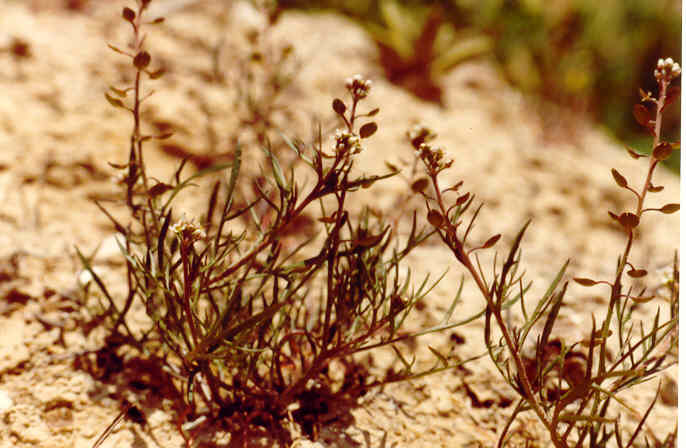
 |
Lepidium
nitidum var. nitidum
Torrey
& A. Gray
Brassicaceae (Mustard Family)Native
Common PeppercressShining Peppercress |
March Photo
Plant Characteristics:
Annual, usually erect and simple at base sometimes spreading branches
from base; stems glabrous to moderately pubescent, .5-4 dm. long; lower leaves
3-10 cm. long, pinnately parted into narrow segments, the cauline smaller,
pinnatifid to entire; racemes rather lax in fruit; pedicels densely puberulent,
very much flattened; sepals ovate, ca. 1 mm. long; petals spatulate .5-l.5 mm.
long, white; silicles ovate to suborbicular, convex below, somewhat concave
above, glabrous, 3.5-6 mm. long, without divergent apices, the margins upturned,
notched at apex, the notch 0.2-0.5 mm. deep.
Habitat:
Common on open places below 3300 feet throughout the state except for the
desert. Feb.-May.
Name:
Greek, lepidion, a little
scale, from the shape of pods. (Munz,
Flora So. Calif. 291).
Nitidum is from the Latin, meaning shining, also referring to the
pods. (Dale 84).
General:
Common in the study area. Photographed
on the North Star Bluffs. (my
comments). The Cahuillas, Indians of the Colorado
Desert, the San Jacinto and San Bernardino Mountains, used L.
nitidum for a hair treatment. The
leaves were boiled and allowed to steep until a brown-colored water was
obtained. This was used to wash the
hair and was said to keep the scalp clean and prevent baldness.
(Bean and Saubel 85).
The small seeds of this and other species were gathered by many Indian
tribes and parched by stirring in a basket with live coals.
They were then ground to a flour and made into mush with other seeds. Mexicans use the seeds of one species as a poultice for
wounds. (Clarke 205-206).
The most common peppergrass in Calif.
(Robbins et al. 230).
The 1993 Jepson Manual lists three varieties of L.
nitidum while Munz, Flora So. Calif. lists only L.
nitidum. In the spring of 1994
I identified var. nitidum as being the
local variety. (my comment).
Text Ref:
Hickman, Ed. 429; Munz, Calif. Flora 228; Munz, Flora
So. Calif. 294; Roberts 16.
Photo Ref:
Feb 1 85 # 10.
Identity: by R. De Ruff.
Computer Ref:
Plant Data 9.
Have plant specimen.
Last edit 10/23/02.
 |
February Photo